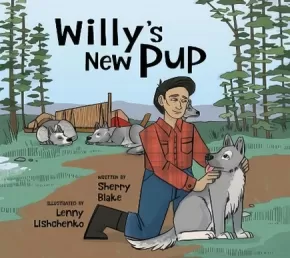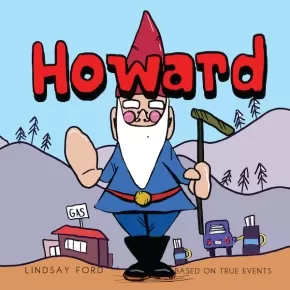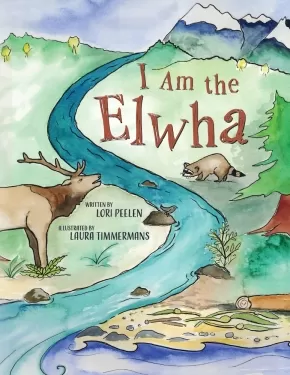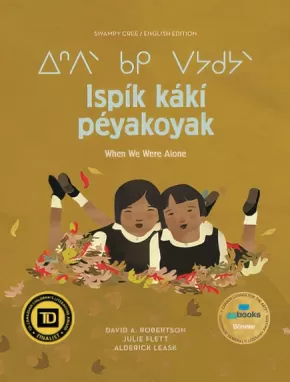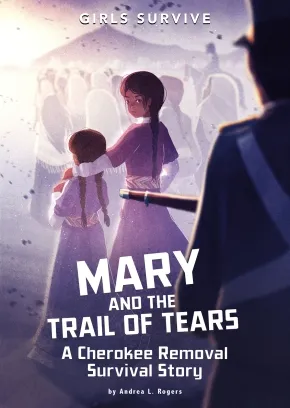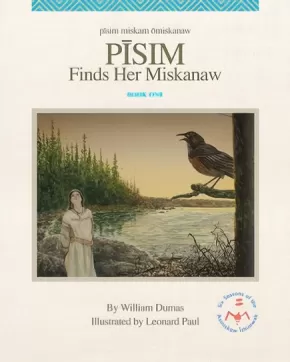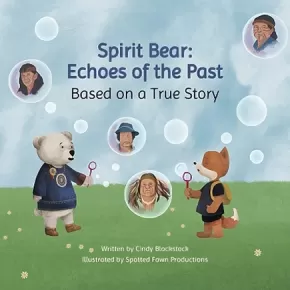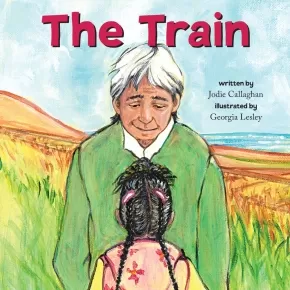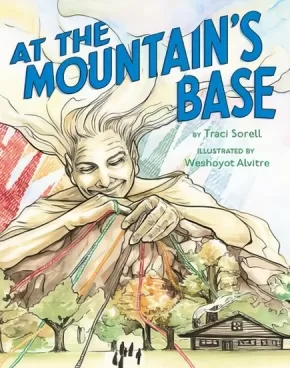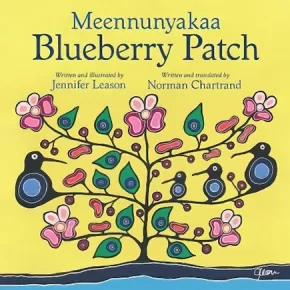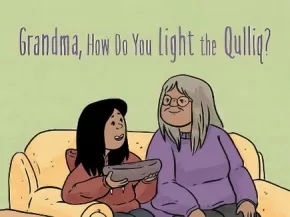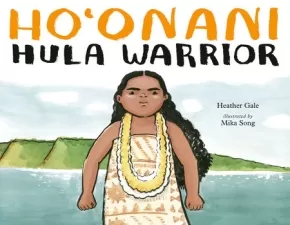
Historical Fiction
46
-
60
of
106 Results;
Sort By
Go To
of 8
Willy's New Pup: A Story from Labrador - Nunavummi Reading Series
$20.95
Artists:
Format:
Hardcover
Text Content Territories:
Indigenous Canadian; Inuit;
ISBN / Barcode: 9781774502709
Synopsis:
Synopsis:
When Willy's friend Sid comes to visit, he brings Willy a surprise—a new pup! Willy's new pup is strong and fast, but he needs a lot of training before he can become the new lead dog. When Willy finally decides his new pup is ready for his first hunting trip, something happens that puts the dog's strength and bravery to the test. Based on true events, this story from Labrador shows the powerful bond between a dog team driver and his lead dog.
Educator & Series Information
Recommended for ages 7 to 9.
This book is part of the Nunavummi Reading Series, a Nunavut-developed series that supports literacy learning while teaching readers about the people, traditions, and environment of the Canadian Arctic. Willy's New Pup is a Level 13 book in the series.
Nunavummi Reading Series books have also been officially levelled using the Fountas & Pinnell Text Level Gradient™ Levelling System. This book's F&P Level is O.
Curriculum Connections: Diversity and Indigenous Perspectives. Willy's New Pup exposes children to Inuit traditions and ways of life.
This story is based on true events that occurred to the author's father.
Additional Information
52 pages | 8.00" x 9.00" | Hardcover | Colour illustrations
Howard
 $18.00
$18.00

Artists:
Format:
Paperback
ISBN / Barcode: 9781775379614
Synopsis:
Synopsis:
Do giants get homesick? What happens when the world’s largest gnome moves from home? A story about being the new kid and for anyone who has moved from home.
Educator & Series Information
Howard – A story about Vancouver Island’s giant gnome that moved from home. How to talk to kids about moving and trying new things? This is a good start. Written in a fun rhyming meter to help develop a child’s reading skills and vocabulary and also keeping their attention as they will want to guess what happens to Howard next.
Part of the Awkward+Awesome children’s book series celebrating unlikely heroes and inner weirdos.
Based on true events.
Suitable for children ages 4-9 and for anyone who experiences change and likes to read.
Additional Information
36 Pages | Paperback
I Am the Elwha (HC)
 $18.50
$18.50

Artists:
Format:
Hardcover
Text Content Territories:
Indigenous American; Native American; Salish; Coast Salish; Klallam (Clallam); Lower Elwha Klallam Tribe;
ISBN / Barcode: 9781771744744
Synopsis:
Synopsis:
“I am the Elwha, rushing down to the sea. I am the Elwha, wild and free.”
The Elwha River flows 72 kilometres (45 miles) from its source in the Olympic Mountains to the Strait of Juan de Fuca in the Pacific Northwest. Uniquely, it hosts all six salmon species (Pink, Chinook, Coho, Sockeye, Steelhead, and Chum) as well as several species of trout.
In 1911 two dams were built on the river. The dams blocked the migration routes of the salmon and dramatically altered the entire river ecosystem for 100 years. In 2012 the dams were decommissioned and the world’s largest dam removal and habitat restoration project began.
In this lyrical and beautifully illustrated book, the author chronicles the history of the Elwha. Narrated by the powerful voices of plants and animals that inhabit the river ecosystem, the dam builder, a worker, and the river itself, this story celebrates the ongoing rewilding of this special environment and offers a welcome to all of the creatures who are coming home.
To learn more visit: www.elwha.org
Awards
- 2021 Riverby Award for Young Readers
Reviews
“I Am the Elwha is a powerful read about a powerful river and those who value and protect it." – Raina Delisle, Hakai Magazine
Educator Information
At the back of the book are three pages of cultural, scientific, and historical information that discuss the following:
- the importance and symbolism of salmon to the Lower Elwha Klallam Tribe and other Coastal Salish Tribes
- facts about the six species of salmon found in the Elwha River (Chinook, Pink, Chum, Sockeye, Coho, and Steelhead)
- the history of the Elwha River and its status today
Keywords / Subjects: The Elwha River, Rivers, Dams, History, Environmental Awareness, Lower Elwha Klallam Tribe, Coast Salish, Native American, Culture, Washington, Animals, Salmon, First Salmon Ceremony, Plants, Nature, Settlers, Social Responsibility, Environmental Activism, Poetry.
Recommended for grades 3 to 7.
Additional Information
32 Pages | 8.5" x 11" | ISBN: 9781771744744 | Hardcover
Authenticity Note: This lyrical story, which chronicles the history of the Elwha River, is written by Lori Peelen. Robert Elofson, Tribal Elder and Harvest Manager in the Natural Resources Department for the Lower Elwha Klallam Tribes, approved Lori's work and contributed a few pages of back matter at the end of the work. Lori's story was further approved by Frances Charles, the Tribal Councilwoman for the Lower Elwha Klallam Tribe, after the entire council read and approved it.
The Canadian Content label has been applied because the illustrator of this work is Canadian.
Ispík kákí péyakoyak/When We Were Alone
$21.95
Artists:
Format:
Hardcover
Text Content Territories:
Indigenous Canadian; First Nations; Cree (Nehiyawak); Swampy Cree ;
ISBN / Barcode: 9781553799054
Synopsis:
Synopsis:
An empowering story of resistance that gently introduces children to the history of residential schools in Canada.
A young girl notices things about her grandmother that make her curious. Why does her grandmother have long, braided hair and beautifully coloured clothing? Why does she speak Cree and spend so much time with her family? As she asks questions, her grandmother shares her experiences in a residential school, when all of these things were taken away.
When We Were Alone won the 2017 Governor General's Literary Award in the Young People's Literature (Illustrated Books) category, and was nominated for the TD Canadian's Children's Literature Award. This edition includes the text in Swampy Cree syllabics and Roman orthography, as well as the original English.
Reviews
"When We Were Alone is a story about finding the strength to push forward when everything is against you. It follows a young girl asking her grandmother questions to learn more about her past. The grandmother shares her experience of a time when she was unable to make her own decisions and how she got through it." — The Dalai Lama Center
Educator Information
Recommended for ages 6 to 8.
This edition includes the text in Swampy Cree syllabics and Roman orthography, as well as the original English.
Translated by Alderick Leask. Alderick Leask is a respected Swampy Cree language instructor originally from Sapotaweyak Cree Nation, Manitoba. His experience includes conducting classes in Native Studies, Native Cultures, Native Languages and Canadian History from the Indigenous perspective using Traditional Elders’ Knowledge (TEK) and land-based learning. Mr. Leask places Creation and its bounties as his background in instructing students when learning basic outdoor survival skills. His usage of the functional and descriptive language of Swampy Cree demonstrates its practicality.
This book is available in an English-only format: When We Were Alone
This resource is also available in French: Quand on etait seuls
Additional Information
32 pages | 7.50" x 10.00" | Hardcover
Mary and the Trail of Tears: A Cherokee Removal Survival Story
$13.99
Format:
Paperback
Text Content Territories:
Indigenous American; Native American; Cherokee;
ISBN / Barcode: 9781496592163
Synopsis:
Synopsis:
Twelve-year-old Mary and her Cherokee family are forced out of their home in Georgia by U.S. soldiers in May 1838. From the beginning of the forced move, Mary and her family are separated from her father. Facing horrors such as internment, violence, disease, and harsh weather, Mary perseveres and helps keep her family and friends together until they can reach the new Cherokee nation in Indian Territory. Featuring nonfiction support material, a glossary, and reader response questions, this story explores the tragedy of forced removals following the Indian Removal Act of 1830.
Reviews
"Highly Recommended. Andrea L. Rogers is a citizen of the Cherokee Nation. Her book, Mary and the Trail of Tears: A Cherokee Removal Survival Story came out on February 1, 2020. I've read it and I've followed conversations about it amongst citizens of the Cherokee Nation and am hoping for a review from a professor, soon. In the meantime, I want to make sure people order it for their children, or their classroom, or their library." — Dr. Debbie Reese, American Indians in Children's Literature
"When kids need reassurance in tough times (like now, for instance), we often point them to examples from the past, to moments of resilience and courage. Mary and the Trail of Tears is ideal for that. The book was lovingly crafted by Cherokee author, mama and educator Andrea L. Rogers. It’s a window to the forced relocation of Cherokee people from what’s currently called Georgia to Indian Territory. But more than that, the story offers an opportunity for kids to really get to know and care about Mary and her family, to relate to the Cherokees of their era as human beings. (For ages 8 to 12)"— NPR's Book Concierge Best Books of 2020, Cynthia Leitich Smith, author of Hearts Unbroken
Educator Information
Recommended for ages 8 to 12.
Additional Information
112 pages | 5.25" x 7.50" | 10 Colour Illustrations | Paperback
Northwest Resistance
$21.95
Artists:
Format:
Paperback
Text Content Territories:
Indigenous Canadian; Métis;
ISBN / Barcode: 9781553798316
Synopsis:
Synopsis:
Echo Desjardins is adjusting to her new home, finding friends, and learning about Métis history. She just can’t stop slipping back and forth in time. One ordinary afternoon in class, Echo finds herself transported to the banks of the Red River in the summer of 1869. All is not well in the territory as Canadian surveyors have arrived to change the face of territory, and Métis families, who have lived there for generations, are losing access to their land. As the Resistance takes hold, Echo fears for her friends and the future of her people in the Red River Valley.
Educator & Series Information
This is volume 3 in the graphic novel series, A Girl Called Echo, by Katherena Vermette.
Books in this series include:
Volume 1: Pemmican Wars
Volume 2: Red River Resistance
Volume 3: Northwest Resistance
Volume 4: Road Allowance Era
Recommended for grades 5 to 9 by publisher.
Katherena Vermette, a Governor General's Award-winning author deftly enters a format typically dominated by male creators with this graphic novel series, A Girl Called Echo. Featuring compelling illustrations, a female main character, and the contemporary foster care system, the series follows Echo Desjardins as she discovers her Métis heritage firsthand while slipping back and forth through time.
This book is available in French: Elle s'appelle Echo Tome 3: La résistance du Nord-Ouest
Additional Information
48 pages | 6.50" x 10.00"
Pisim Finds Her Miskanaw: Revised
$29.00
Artists:
Format:
Hardcover
Text Content Territories:
Indigenous Canadian; First Nations; Cree (Nehiyawak); Woodland Cree; Rocky Cree;
ISBN / Barcode: 9781553799092
Synopsis:
Synopsis:
NOW REVISED! This edition features updated Rocky Cree translations and an expanded glossary, augmented with new maps to give a more detailed look at Pīsim’s journey. These enhancements make this book a great tool for teachers and a great addition to any library.
Out of an important archaeological discovery came this unique story about a week in the life of Pīsim, a young Cree woman, who lived in the mid 1600s. In the story, created by renowned storyteller William Dumas, Pīsim begins to recognize her miskanaw – the path for her life – and to develop her gifts for fulfilling that path. The story is brought to life by the rich imagery of Mi’kmaw artist Leonard Paul, and is accompanied by sidebars on Cree language and culture, archaeology and history, maps, songs, and more.
Reviews
"In imagining the life of a young Cree woman, this volume provides a wonderful evocation of the wisdom and language of Cree elders that seamlessly incorporates archaeology, ethnology, and oral traditions." — Stephen Loring, Arctic Studies Center, Smithsonian Institute, Washington DC
"This rich story ... brings alive the history and language of Asiniskow Ithiniwak in Manitowapow while illustrating the cultural breadth of a dynamic community. This book is a joy to read, teach, and share with my daughter." — Niigaanwewidam James Sinclair, Assistant Professor, Dept. of Native Studies University of Manitoba
"The brilliant teamwork between archaeologists, the Cree, and an accomplished storyteller gives us... a beautifully written and illustrated journey into a centuries-old world... the books promises to be a classic of Canadian history." — Brian Fagan, Emeritus Professor of Anthropology, University of California, Santa Barbara, and author of The First North Americans
Educator & Series Information
Pīsim Finds Her Miskanaw is book one in The Six Seasons of the Asiniskow Īthiniwak series about the Asiniskow Īthiniwak (Rocky Cree) of Northern Manitoba. Corresponding to the six seasons of sīkwan (spring), nīpin (summer), takwakin (fall), mikiskow (freeze-up), pipon (winter), and mithoskamin (break-up), the books explore the language, culture, knowledge, territory, and history of the 17th century Rocky Cree people through story and images. The groundbreaking series centres Indigenous ways of knowing and includes insights from a wide range of disciplines – cross-cultural education, history, archaeology, anthropology, linguistics, literature, oral culture and storytelling, experiential and community-based learning, and art.
Recommended for ages 9 to 12.
Reading Level: Lexile® Framework for Reading: 940L
Contains some Cree language.
Additional Information
60 pages | 10.00" x 12.00" | Revised | Hardcover
Spirit Bear: Echoes of the Past: Based on a True Story
$12.95
Artists:
Format:
Paperback
Text Content Territories:
Indigenous Canadian; First Nations;
ISBN / Barcode: 9781777009137
Synopsis:
Synopsis:
For the past 13 years, Spirit Bear has been working hard to make sure First Nations children get the help they need when they need it so they can grow up safely with their families, get a good education, and be healthy and proud of who they are.
It's been a long journey, and Spirit Bear needs a vacation! He and his family set out for Songhees and Esquimalt territories (Victoria, British Columbia) for their holiday adventure. Along the way, they see a statue of John A. Macdonald - Canada's first Prime Minister - being removed from the steps of Victoria City Hall. Some people have signs that say, "Save the statue," and others have signs that say, "The statue must go!" Spirit Bear and his family learn why people disagree and how we can learn from the good and bad parts of history to make better decisions now and for future generations of First Nations, Métis, and Inuit kids.
Educator & Series Information
Recommended for ages 6 to 12.
This book is part of the Spirit Bear series.
This book is available in French: Spirit Bear: echos du passe: Base sur une histoire vraie
Additional Information
51 pages | 8.25" x 8.25"
The Train
$19.95
Artists:
Format:
Hardcover
Text Content Territories:
Indigenous Canadian; First Nations; Mi'kmaq;
ISBN / Barcode: 9781772601299
Synopsis:
Synopsis:
“I’m waiting for what we lost that day to come back to us.”
Ashley meets her great-uncle by the old train tracks near their community in Nova Scotia. When she sees his sadness, he shares with her the history of those tracks. Uncle tells her that during his childhood the train would bring their community supplies, but there came a day when the train took away with it something much more important. One day he and the other children from the reserve were taken aboard and transported to residential school, where their lives were changed forever. They weren't allowed to speak Mi'gmaq and were punished if they did. Uncle tells her he tried not to be noticed, like a little mouse, and how hard it was not to have the love and hugs and comfort of family. He also tells Ashley how happy she and her sister make him. They are what give him hope. Ashley promises to wait with her uncle as he sits by the tracks, waiting for what was taken from their people to come back to them.
Awards
- Co-winner of Second Story Press's Indigenous Writing Contest in 2018
Educator Information
Recommended for ages 6 to 9 (grades 1 to 3)
The Train is an intergenerational story of healing from trauma. The legacy of abuse of North America's Indigenous peoples is something that affects all of us, and this book is another important resource to start that conversation with young people.
The Train can be empowering for children whose families and communities have lived through trauma, as they can learn about the history and that they are strong enough to carry that knowledge and be the change we need.
Subjects / Themes: Character Education: Empathy, Family, Friendship; History & Social Studies: Canadian History, First Nations and Indigenous Peoples; Reflecting Diversity.
This book is available in a dual-language (Mi'gmaq and English) format: Ga's / The Train
Additional Information
32 pages | 8.50" x 8.50" | colour illustrations | picture book
At the Mountain's Base
$25.99
Artists:
Format:
Hardcover
Text Content Territories:
Indigenous American; Native American; Cherokee;
ISBN / Barcode: 9780735230606
Synopsis:
Synopsis:
A family, separated by duty and distance, waits for a loved one to return home in this lyrical picture book celebrating the bonds of a Cherokee family and the bravery of history-making women pilots.
At the mountain's base sits a cabin under an old hickory tree. And in that cabin lives a family -- loving, weaving, cooking, and singing. The strength in their song sustains them through trials on the ground and in the sky, as they wait for their loved one, a pilot, to return from war.
With an author's note that pays homage to the true history of Native American U.S. service members like WWII pilot Ola Mildred "Millie" Rexroat, this is a story that reveals the roots that ground us, the dreams that help us soar, and the people and traditions that hold us up.
Additional Information
32 pages | 9.38" x 11.81"
Blueberry Patch / Meennunyakaa
$19.95
Artists:
Format:
Hardcover
Text Content Territories:
Indigenous Canadian; First Nations; Anishinaabeg; Ojibway; Saulteaux;
ISBN / Barcode: 9781926886589
Synopsis:
Synopsis:
Based in Duck Bay, Manitoba, in the 1940s, an Elder shares his experience of packing up to go out to collect blueberries, a traditional gathering that took place every summer. He describes the journey and landscape with humor and such vivid imagery that readers will see themselves there with him, boarding the trail of wagons from surrounding communities and heading east toward the blueberry patch. The Elder's stories offer a journey back in time and are complemented by images of fields of plump blueberries, tall green grass, bannock baking over an open fire, clear freshwater streams and the tents the people slept in.
Educator Information
Written in English and Anishinaabemowin. Includes a page of after-reading activities for kids at the back of the book that both test reading comprehension and encourage further inquiry and exploration.
Recommended for ages 6-8.
Themes: Manitoba, Berries, Food Sovereignty, Indigenous, Traditions, Food, Culture, Family, Community, Anishinaabe.
Includes a recipe for bannock.
Translated by Norman Chartrand.
Recommended in the Canadian Indigenous Books for Schools 2020/2021 resource list as being useful for grades K-3 in these areas: English Language Arts, Art, Math, Science, and Social Studies.
Additional Information
32 pages | 8.00" x 8.00"
Celebrating Toonik Tyme - Nunavummi Reading Series
$7.95
Artists:
● Tim Mack
Format:
Paperback
Text Content Territories:
Indigenous Canadian; Inuit;
ISBN / Barcode: 9781774501801
Synopsis:
Synopsis:
Toonik Tyme is a lot of fun!
This book describes different things that happen during Toonik Tyme, an annual festival in Iqaluit that celebrates Inuit traditions and the return of spring.
Educator & Series Information
This book is part of the Nunavummi Reading Series, a Nunavut-developed series that supports literacy learning while teaching readers about the people, traditions, and environment of the Canadian Arctic. It is a Level 7 book in the series.
Nunavummi Reading Series books have also been officially levelled using the Fountas & Pinnell Text Level Gradient™ Levelling System. This book's F&P Level is E.
Curriculum Connections: Language and literacy; Indigenous perspectives; Community engagement; History; Heritage
Recommended for ages 5-7.
Additional Information
16 pages | 10.00" x 10.00"
Encounter
$24.99
Artists:
Format:
Hardcover
Text Content Territories:
Indigenous Canadian;
ISBN / Barcode: 9780735265813
Synopsis:
Synopsis:
Two people navigate their differences with curiosity and openness in this stunning picture book that imagines the first meeting between an Indigenous fisher and a European sailor.
Based on an actual journal entry by French explorer Jacques Cartier from his first expedition to North America in July 1534, this story imagines the first encounter between a European sailor and a Stadaconan fisher. As the two navigate their differences (language, dress, food) with curiosity, the natural world around them notes their similarities. The seagull observes their like shadows, the mosquito notes their equally appealing blood, the mouse enjoys the crumbs both people leave behind.
This story explores how encounters can create community and celebrates varying perspectives and the natural world. It is at once specific and universal. It's a story based on a primary document and historical research, but it is in equal measure beautifully imagined. It makes room for us to recognize our differences while celebrating our shared humanity.
Debut author Brittany Luby's background in social justice and history brings a breathtaking depth of insight and understanding to this story and Michaela Goade's expressive art brings equal life to the creatures and landscapes. An author's note outlines the historical context as well as situates the story in the present day.
Reviews
"Shared humanity is at the center of this Indigenous author and illustrator team’s alternative history.... Encounter’s most valuable aspect is its backmatter: Both an author’s reflection and a historical note offer crucial context to this spirited revision. “This peaceful encounter does not forgive…violent actions,” Luby notes. “Instead, it reminds us…that everyday people, like Sailor, can participate in systems that hurt others.” Without this addendum, this story runs the risk of obscuring legacies of violence rather than “learn[ing] from our history and tak[ing] the opportunity to map a better future.”
"An uplifting, #ownvoices vision for what could have been and what we are responsible for now." - Kirkus Reviews
Educator Information
Recommended for ages 3 to 7
Includes an author's reflection and historical note that provide crucial context to the events in the story.
Additional Information
40 pages | 8.50" x 10.63"
Grandma, How Do You Light the Qulliq? - Nunavummi Reading Series
$8.95
Artists:
Format:
Paperback
Text Content Territories:
Indigenous Canadian; Inuit;
ISBN / Barcode: 9781772668735
Synopsis:
Synopsis:
Learn all about the history and traditional uses of the qulliq.
In this book, a grandmother teaches her grandchild how to light a qulliq and tells her about its history and traditional uses.
Educator & Series Information
This book is part of the Nunavummi Reading Series, a Nunavut-developed series that supports literacy learning while teaching readers about the people, traditions, and environment of the Canadian Arctic. It is a Level 9 book in the series.
Nunavummi Reading Series books have also been officially levelled using the Fountas & Pinnell Text Level Gradient™ Levelling System. F&P Level of this book: L.
Curriculum Connections: Language and Literacy; Diversity; Indigenous Perspectives; History and Heritage.
Recommended for ages 6 to 8.
Additional Information
32 pages | 8.00" x 6.00"
Ho'onani: Hula Warrior
$21.99
Artists:
Format:
Hardcover
Text Content Territories:
Indigenous Hawaiian;
ISBN / Barcode: 9780735264496
Synopsis:
Synopsis:
An empowering celebration of identity, acceptance and Hawaiian culture based on the true story of a young girl in Hawaiʻi who dreams of leading the boys-only hula troupe at her school.
Ho'onani feels in-between. She doesn't see herself as wahine (girl) OR kane (boy). She's happy to be in the middle. But not everyone sees it that way.
When Ho'onani finds out that there will be a school performance of a traditional kane hula chant, she wants to be part of it. But can a girl really lead the all-male troupe? Ho'onani has to try . . .
Based on a true story, Ho'onani: Hula Warrior is a celebration of Hawaiian culture and an empowering story of a girl who learns to lead and learns to accept who she really is--and in doing so, gains the respect of all those around her.
Ho'onani's story first appeared in the documentary A Place in the Middle by filmmakers Dean Hamer and Joe Wilson.
Reviews
“Boldly outlined watercolor and ink artwork . . . convey visual information with strength that suggests Ho‘onani’s own. And Gale grounds the child’s experience, based on a true story, in Hawaiian traditions, modeling showing ‘every person the same unconditional acceptance and respect’.” --Publishers Weekly, starred review
“Ho'onani’s courage to be true to herself and her place in the middle is empowering. Hawaiian words are intermixed, and Song’s illustrations are full of emotion and determination.” --Kirkus Reviews
“Ho’onani: Hula Warrior tells the story of a young gender-nonconforming child who, though she still uses female pronouns, does not wish to be either a girl or a boy. Ho’onani is seen by some as too loud, too brash, too masculine. But when she starts to show an interest in leading a group of students in a hula chant, some don’t believe she can do it because she’s not a boy, not strong enough, not bold enough! Stuck in the middle but not willing to back down, Ho’onani and her teacher, Kumu Hina (“kumu” means teacher), work to build her skills and prepare her to take the tests necessary to show that she is skilled enough to lead. And while her parents and brother are not very surprised at Ho’onani’s determination, Kana, her sister, is less than pleased and stops hanging out with Ho’onani like they used to. But in the end, Ho’onani works hard and continues to buck stereotypes in the process, ultimately bringing her closer to her goal with each passing day, until the moment arrives when she must prove herself in front of the whole community.
This empowering and delightfully engaging picture book is based on the true story of Ho’onani Kamai who was raised in Honolulu and was coached by Hinaleimoana Kwai Kong Wong-Kalu (shortened in the book to Kumu Hina). An author’s note at the beginning gives a more detailed explanation of the real-life story, some history and a mention of the documentary (A Place in the Middle) which was inspired by Ho’onani and Kumu Hina’s working together.
.... The story is not simply one of strength and overcoming obstacles, but it is also a story about traditions, acceptance, and respect for others. Ho’onani is not simply a determined youngster, but also an individual trying to help others understand that gender stereotypes are harmful and limiting. Gale’s picture book will help young readers and adults better understand a small slice of Hawaiian traditions and nonbinary people, referred to as Mahu, those who embody both feminine and masculine traits.
.... An entertaining, illuminating, and empowering read, Ho’onani: Hula Warrior will make a welcome addition to classrooms, libraries, and story times!” --CM Magazine
Educator Information
Recommended for ages 4-8.
The author thanks Ho'onani Kamia and Kumu Hina on her website for allowing her to write this story.
Additional Information
40 pages | 8.80" x 11.40"
Sort By
Go To
of 8

